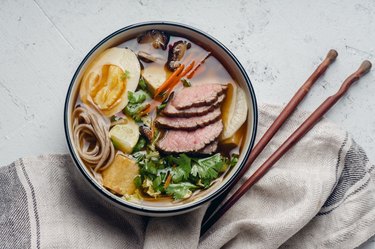
Economical and easy to make, ramen is a simple dish consisting of quick-cooking noodles served in broth, often with meat and vegetables. While most ramen noodles are made with wheat flour, there are gluten-free ramen varieties available.
If you avoid gluten for preference or allergies, read nutrition labels carefully to be sure you're eating gluten-free noodles.
Video of the Day
Video of the Day
What Is Gluten?
Gluten is a general name for various proteins found primarily in wheat, barley, rye and triticale. According to the Celiac Disease Foundation (CDF), gluten acts like a "glue" in many different types of foods, helping to maintain their shape.
Although gluten can commonly be found in noodles, breads, cereals and snack foods, it's also included in places you might not imagine it to be. For example, many soups, sauces, salad dressings and beers have gluten in them.
For some people, eating gluten causes problems — ranging from mild to life-threatening. Those with celiac disease who consume gluten will experience an autoimmune response whereby the body attacks the small intestine, the CDF explains.
Others may have a wheat allergy to any of the hundreds of proteins in wheat, says the Gluten Intolerance Group. For these people, eating wheat can trigger immune responses such as nausea, abdominal pain, itching, swelling of the lips and tongue, difficulty breathing or anaphylaxis. They may be able to eat certain gluten-containing foods from non-wheat sources, but they must avoid eating any form of wheat.
Yet another group of people may have non-celiac gluten sensitivity. This condition is also believed to involve the immune system, according to CDF. However, it remains largely misunderstood, making diagnosis more challenging.
Eating Gluten-Free Noodles
Although many ramen noodles contain gluten, you can find gluten-free ramen at most grocery stores or specialty markets. Gluten-free noodles may be made from rice flour, buckwheat flour (also known as soba, a noodle of Japanese origin) or other types of naturally gluten-free flours.
You'll need to read through the ingredients on nutrition labels carefully to ensure the product is 100 percent gluten-free, however. The seasoning packets or broth in packaged ramen may contain derivatives of barley, rye, wheat and other gluten-containing ingredients, even if the noodles are gluten-free. You can also look for the "gluten-free" label on food packaging.
To be labeled gluten-free, a product must meet certain requirements established by the U.S. Food and Drug Administration (FDA) in a rule set forth in August 2013. According to the rule, manufacturers may voluntarily use the term "gluten-free" on products that are inherently gluten-free or that have no ingredients containing gluten. Any unavoidable presence of gluten must not exceed 20 parts per million.
Tips for Avoiding Gluten
Even if you're being cautious and buying gluten-free noodles, you can experience gluten cross-contamination, especially if you don't prepare the food yourself. If you go out to eat, your gluten-free ramen may indeed contain gluten if it's cooked on the same equipment as gluten-containing foods.
The same is true if a chef doesn't change gloves between handling your gluten-free ramen and handling a dish containing gluten. To avoid having your gluten-free noodles contaminated, be sure to tell your server you have a gluten allergy.
You can also avoid cross-contamination by making ramen noodles yourself, using gluten-free ingredients. Another healthy option is to spiralize zucchini, squash or sweet potato into a noodle shape and use these "noodles" in a ramen dish.
Eating gluten-free might make your diet more challenging, given the prevalence of gluten-containing foods in supermarkets and restaurants. However, with a little knowledge and preparation, you can safely avoid gluten and create tasty gluten-free ramen dishes of your own.
- Celiac Disease Foundation: "What Is Celiac Disease?"
- Celiac Disease Foundation: "JAMA’s Review of Celiac Disease and Non-Celiac Gluten Sensitivity"
- Gluten Intolerance Group: "Celiac Disease, Non-Celiac Gluten Sensitivity or Wheat Allergy: What Is the Difference?"
- U.S. Food and Drug Administration: "Questions and Answers on the Gluten-Free Food Labeling Final Rule"